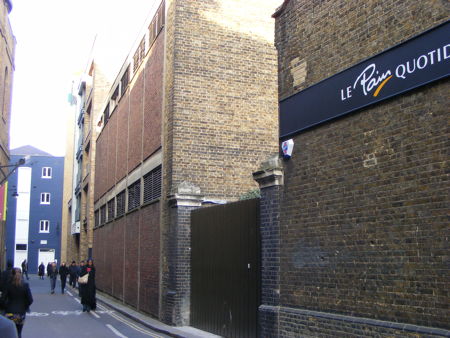Planning inspector to decide on Stoney Street restaurant scheme
Two architects have clashed over a proposed new restaurant and housing development in Stoney Street at a planning appeal.

At Southwark Town Hall on Tuesday planning inspector Tim Wood heard an appeal by St John's Heritage Developments against Borough and Bankside Community Council's unanimous refusal to grant planning permission last November.
The 38 Stoney Street site, to the north of Le Pain Quotidien, also has a frontage on Winchester Square. The plan is for a restaurant seating at least 150 diners on two levels and 9 flats on upper floors.
The inspector Tim Wood looked at three issues: The effects of the proposed design and the materials generally and on the conservation area, the effects of the proposal in relation to the amenity of residents and whether the proposal would give rise to unacceptable levels of noise and disturbance.
Graham Morrison, whose architectural practice Allies and Morrison is in nearby Southwark Street, spoke as a local resident against the appeal.
In a written submission he suggested that the site held a pivotal position in the urban fabric with Winchester Walk having become the dividing line between "the residential area to the north and the expanding Borough Market and its wall-to-wall bars and restaurants to the south".
During the hearing, when he also referred to himself as both a property developer and a restaurateur, he questioned why the building was turning its back on Winchester Square which some time in the future would become a significant urban space.
Mr Morrison also criticised the double height glazing and a "steel channel that separates the bottom from the top of the building".
He added: "This horizontal division is an alien element in the street. It's true that towards Borough Market there are more commercial buildings. In fact the joy of many buildings in Stoney Street and Clink Street are their solidity in the sense the walls carry the gravity of their weight down to the ground."
In criticising the concept of requiring a purpose built restaurant structure he asked: "Why can't we have a building that is capable of some flexibility?"
Sean Silk, appearing for the developers, described the plan as "crisp simplicity born out of its functionality".
Malcolm Pawley, architect of the proposed building, said he had been working in the Borough High Street conservation area since 1986 where he had completed 22 projects.
"We know the history and we know its architectural inheritance," he said, adding that his practice had a reputation "for sensitive and individual work".
He said that the plan would reintroduce a pedestrian access between Stoney Street and Winchester Square as shown on a 1794 map.
"We are proposing to demolish an existing Sixties warehouse to the benefit of the area and replace it with a modern building of high quality. It will make a valuable contribution to the conservation area."
Graham Morrison later described the management plan as "risible" and suggested that any plan should be attached to the building owner rather than a business. He said that Clink Street residents had serious concerns about increased late night noise, drunkeness and taxi traffic.
The day ended with a site visit where the inspector met other local residents who were at the appeal.
The opening of the appeal was delayed by fifteen minutes after the inspector and several people due to give evidence had been directed to the wrong room by Town Hall staff.
Comments
Share
The SE1 website is supported by people like you
More to read
Related forum discussions
Follow us
Email newsletter
For the latest local news and events direct to your inbox every Monday, you need our weekly email newsletter SE1 Direct.

